Eight Bridges
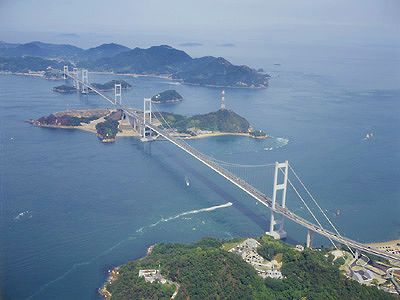
(hashi900.jpg)

Hi Kato, welcome back to Vancouver!

Nice to be here with you, Diane.
How did you enjoy the stay in Japan?
Oh ..., it was marvellous. You see, it was as if I met the first love.
You're over-reacting as usual, Kato.
No, not really. I enjoyed the fireworks in October.

Fireworks in autumn!? ... Amazing!

Besides, I loved to taste local dishes at the all-Japan foodfare.

I wish I'd been with you and enjoyed various dishes like a horse.

I know ... I know ... That's the reason I've brought the taste of Japan all the way from Kyoto---the ancient capital of Japan.
The taste of Japan?
Oh yes, I gave you five pieces of Japanese sweets. How did you like those?
Well ... They taste quite different from other Canadian sweets. What are they called?
They are called "Yatsuhashi" or "Eight Bridges"---if I translate it into English literally.
Yatsuhashi (八ツ橋)

(Baked yatsuhashi)
Yatsuhashi is a Japanese confectionery sold mainly as a souvenir sweet (miyagegashi).
It is one of the best known meibutsu (famous regional products) of Kyoto.
It is made from glutinous rice flour, sugar and cinnamon.
Baked, it is similar to senbei.

(Unbaked yatsuhashi)
Raw, unbaked yatsuhashi (Nama yatsuhashi) has a soft, mochi-like texture and is often eaten wrapped around red bean paste, and may come in a variety of different flavours.
Most notable to the Kyoto area is the black version of this.
The addition of black bean powder to the wrapper gives a distinctive black color.
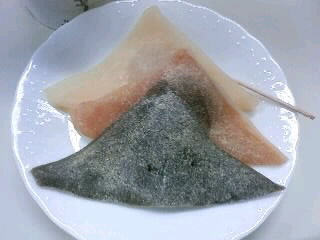
(8hashiw.jpg)
(Black yatsuhashi)
SOURCE: "Yatsuhashi"
From Wikipedia, the free encyclopedia

(Baked yatsuhashi)
Yatsuhashi is a Japanese confectionery sold mainly as a souvenir sweet (miyagegashi).
It is one of the best known meibutsu (famous regional products) of Kyoto.
It is made from glutinous rice flour, sugar and cinnamon.
Baked, it is similar to senbei.

(Unbaked yatsuhashi)
Raw, unbaked yatsuhashi (Nama yatsuhashi) has a soft, mochi-like texture and is often eaten wrapped around red bean paste, and may come in a variety of different flavours.
Most notable to the Kyoto area is the black version of this.
The addition of black bean powder to the wrapper gives a distinctive black color.

(8hashiw.jpg)
(Black yatsuhashi)
SOURCE: "Yatsuhashi"
From Wikipedia, the free encyclopedia

Ummmm ... quite interesting. So, I experienced the taste of Kyoto, didn't I?

Yes, you're telling me.
But I notice that the one you gave me is a little bit diffetent from the unbaked yatsuhashi in the above picture.
... different?
Yes, I mean its color. The one I tasted is a bit yellow.
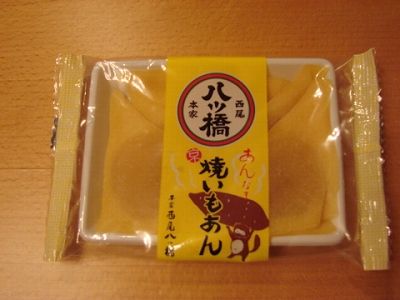
(8hashiy.jpg)

Do you see the difference?

Yes, I do. The above pack contains five pieces. The actual piece is like this:
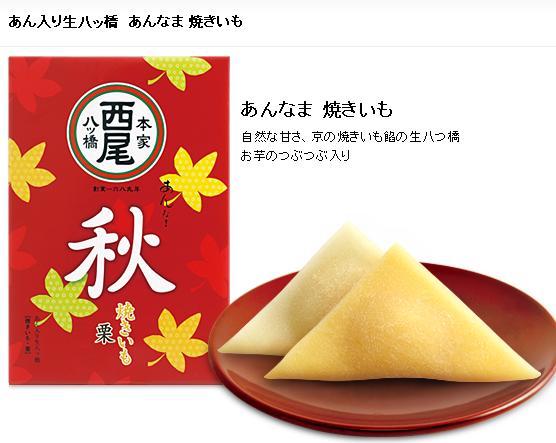
(8hashiz.jpg)

As you said, its color is yellowish.

Why is that?
Well ..., the one you tasted is a real McCoy.
What do you mean?
It was made by the original confectionery factory that was founded in 1689.
Are you saying it was founded 323 years ago?
Yes, you're right on that, Diane.
I can hardly believe it.
If you're in doubt, I'll show you the homepage of the original confectionery.
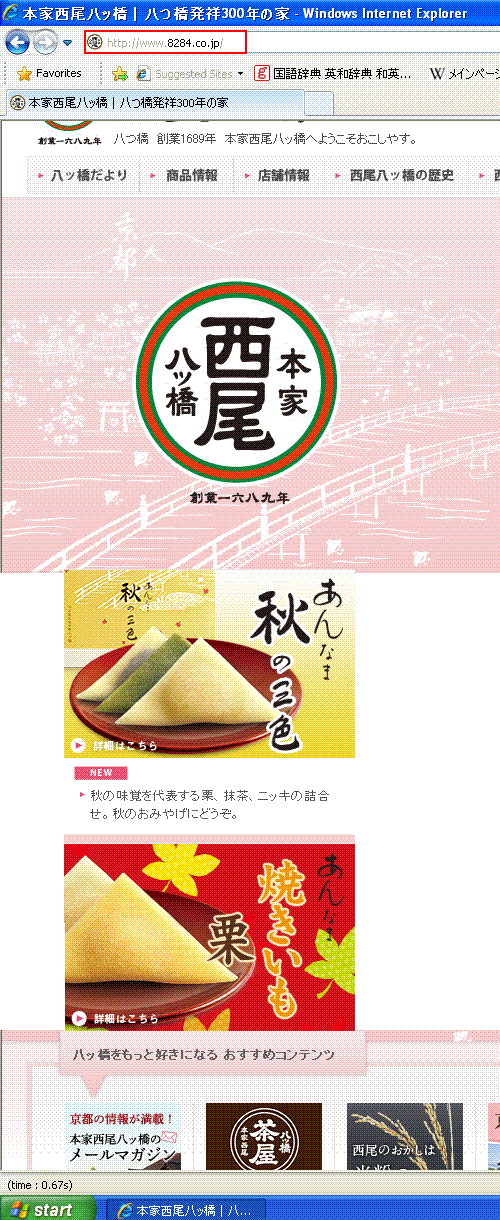
(8hashix.gif)
■"Actual Page"

This confectionery called Nishio (西尾) was opened 323 years ago as a tea house on the street to Shogo-in (聖護院) Temple in Kyoto.
Original Confectionery Shop

The Confectionery Shop has a tradition of 323 years.

Wow! So I tasted the real McCoy, didn't I?
Yes, you did. Diane, did you like the original yatsuhashi?
Yes, of course. By the way, how come it is called "Eight Bridges"?
Good question! Nobody knows it for sure, but there are two theories. One theory goes like this. There was a musician called Yatsuhashi Kengyō (八橋 検校; 1614–1685), who lived in Kyoto. The name Kengyō is an honorary title given to highly skilled blind musicians.
Did he play the guitar?
Oh no, he was originally a player of the shamisen (三味線: three-string guitar), but later he learned the koto (箏) from a musician of the Japanese court.
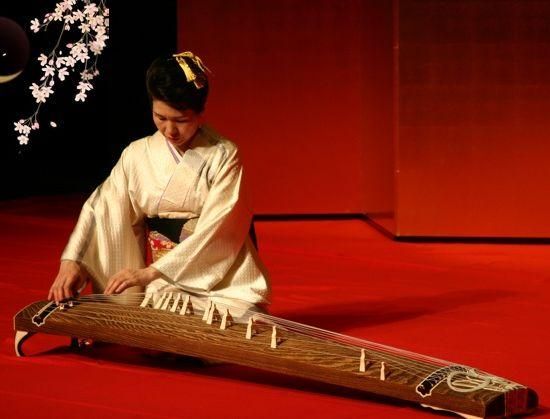
(koto800.jpg)

Yatsuhashi is credited as the first musician to introduce and teach the koto to general audiences. He is thus known as the "Father of Modern Koto."

I see.
He changed the limited selection of six pieces to a brand new style of koto music which he called kumi uta. Yatsuhashi changed the Tsukushi goto tunings, which were based on tunings used in gagaku (雅楽: ancient Japanese music), and with this change a new style of koto was born. He adapted the Hirajoshi scale and the Insen scale for the koto, from the shamisen repertoire. Yatsuhashi is also credited as the composer of the important koto solo piece Rokudan-no-shirabe (六段の調, Music of Six Steps), although he may not actually have composed it himself.
Rokudan-no-shirabe
(六段の調)

Ummm ... sounds quite interesting! But how come the sweet is related to the musician?

Well ..., they say, the shape of the sweet is just like the shape of the koto (箏) the famous Yatsuhashi played.
I don't think both are alike. How about the other theory?
There is a classic story called "Ise Monogatari (伊勢物語)"---a Japanese collection of waka poems and associated narratives, dating from the 9th century. Its chapter nine is called "Kaki-tsubata", in which Yatsuhashi in Mikawa (三河国) region is told. The sweet eaten in this tale is somewhat similar to the one made in the Kyoto confectionery factory. So the factory owner called it "Yatsuhashi."
I see ... but, Kato, why did you choose these sweets for me?
Good question! I have a love story about Yatsuhashi.
Tell me.
Well ... this article is getting long. I'll tell you the next time.
Tsk, tsk, tsk, ... I can hardly wait.

【Himiko's Monologue】

I'm glad that Kato introduced "Yatsuhashi" to the world.
As you see, Yatsuhashi is the famous regional product of Kyoto---my hometown where I was born and brought up, and now teaching the tale of Genji (源氏物語) at Kyoto Women's College.
When you happen to visit Kyoto, please take a bite of Yatsuhashi---the taste of the ancient capital.
In any case, I hope Kato will write another interesting article soon.
So please come back to see me.
Have a nice day!
Bye bye ...


I'm glad that Kato introduced "Yatsuhashi" to the world.
As you see, Yatsuhashi is the famous regional product of Kyoto---my hometown where I was born and brought up, and now teaching the tale of Genji (源氏物語) at Kyoto Women's College.
When you happen to visit Kyoto, please take a bite of Yatsuhashi---the taste of the ancient capital.
In any case, I hope Kato will write another interesting article soon.
So please come back to see me.
Have a nice day!
Bye bye ...


If you've got some time,
Please read one of the following artciles:

■"Madame Riviera and Burger"
■"Roly-poly in the North"
■"Amazing Grace"
■"Diane in Paris"
■"Diane in Montmartre"

■"Diane Well Read"
■"Wantirna South"
■"Maiden's Prayer"
■"Bandwidth"
■"Squaw House and Melbourne Hotel"

■"Tulips and Diane"
■"Diane in Bustle Skirt"
■"Diane and Beauty"
■"Lady Chatterley and Beauty"
■"Victorian Prudery"

■"Diane Chatterley"
■"From Canada to Japan"
■"From Gyoda to Vancouver"
■"Film Festival"
■"Madame Taliesin"
■"Happy Days"
■"Vancouver Again"
■"Swansea"

■"Midnight in Vancouver"
■"Madame Lindbergh"
■"Dead Poets Society"
■"Letters to Diane"
■"Taliesin Studio"

■"Wright and Japan"
■"Taliesin Banzai"
■"Memrory Lane to Sendai"
■"Aunt Sleepie"
■"Titanic @ Sendai"
■"Birdcage"

(sylvie121.jpg)
■"Roly-poly in the wild"
■"Silence is dull"
■"Zen and Chi Gong"
■"Piano Lesson"
■"Dangerous Relation"
■"Electra Complex"

(juneswim.jpg)
■"Covent Garden"
■"Fatal Relation"
■"Notre Dame"
■"Anne Frank"
■"Biker Babe"
■"Diane Girdles the Globe"
■"Diane in Casablanca"
■"Infidelity Neighbourhood"
■"Forest Bathing"
■"Enjoy Ramen!"
■"Sex, Violence, Love"
■"Halifax to Vancouver"
■"A Thread of Destiny"
■"Fujiyama Geisha"
■"Beaver Lake"
■"God is Near!"
■"Holy Cow@Rose Garden"
■"Vancouver Earthquake"
■"Birthplace"
■"KIFF"
■"You Love Japan, eh?"


Hi, I'm June Adams.
Ise Monogatari (伊勢物語) is a Japanese collection of waka poems and associated narratives, dating from the Heian period.
The current version collects 125 sections, with each combining poems and prose, giving a total of 209 poems in most versions.
The exact date of composition and authorship can only be speculated; the identity of the nameless, idealised central character is likewise ambiguous, but suggested to be Ariwara no Narihira (在原 業平: 825-880).
Thirty of the poems from Ise Monogatari appear in the Kokin Wakashū (古今和歌集 edited in 905), with similar headnotes, all attributed to Narihira.
The combination of these poems, and the similarity of some events in the tales to Narihira's life, have led to the additional suggestion that Narihira actually composed the work; however, the inclusion of material and events dating after 880 suggests otherwise.

ところで、愛とロマンに満ちた
レンゲさんのお話をまとめて
『レンゲ物語』を作りました。
もし、レンゲさんの記事をまとめて読みたいならば、
次のリンクをクリックしてくださいね。
■『愛とロマンのレンゲ物語』

■『軽井沢タリアセン夫人 - 小百合物語』
とにかく、今日も一日楽しく愉快に
ネットサーフィンしましょうね。
じゃあね。







0 件のコメント:
コメントを投稿